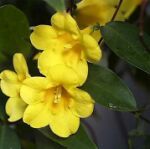| Common Name: |
Carolina Jasmine |
| Other Names: |
Yellow Jessamine |
| Botanical Name: |
Gelsemium sempervirens |
| Genus: |
Gelsemium |
| Family: |
Loganiaceae |
| Native Location: |
SE USA, Mexico, Guatemala |
| Cultivation: |
Moist, fertile, well-drained soil in sun. Thin out stems in spring or after flowering. |
| Propagation: |
By seed sown in spring at 13-18°C (55-64°F) (species only); by semi-ripe cuttings in summer. |
| Harvest: |
Roots and rhizomes are lifted in autumn and dried for decoctions and tinctures. |
| Height: |
3-6m (10-20ft) |
| Hardiness: |
Z7-9 |
| Parts Used: |
Roots and Rhizomes |
| Properties: |
A bitter, slightly aromatic, sedative herb the lowers fevers, increases perspiration, relieves pain, and relaxes spasms. |
| Medicinal Uses: |
Internally for neuralgia, migraine, sciatica, toothache, severe pain (especially in terminal illness or accidents), and meningitis. May be combined with Lavandula angustifolia (See, lavender), or Rosmarinus officinalis (See, rosemary) and Piscidia piscipula (See, Jamaica dogwood), for migraine. Excess causes respiratory depression, giddiness, double vision, and death. Not given to patients with heart disease, hypotension, or myasthenia gravis. Also in homeopathy for feverish illnesses (including influenza and measles) and acute anxiety. For use by qualified practitioners only. |
| Warning: |
Toxic if eaten (one flower may be fatal to a child). Skin allergen. Contact may cause systemic poisoning.
This herb and its alkaloids are subject to legal restrictions in some countries. |
| Bibliography: |
The Encyclopedia of Herbs by Deni Brown Copyright © 1995, 2001 Dorling Kindersley Limited. pp 221-222. |

